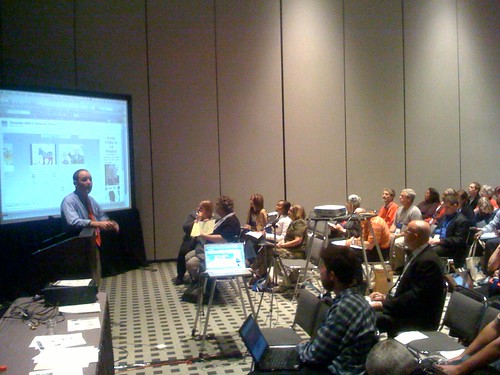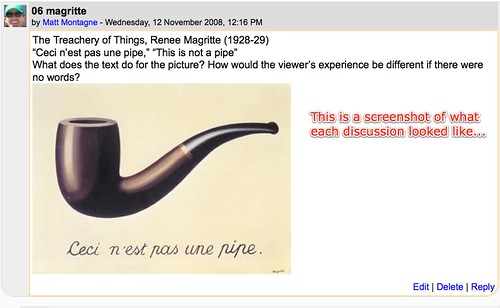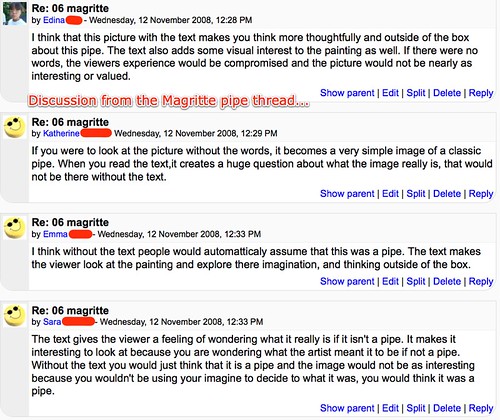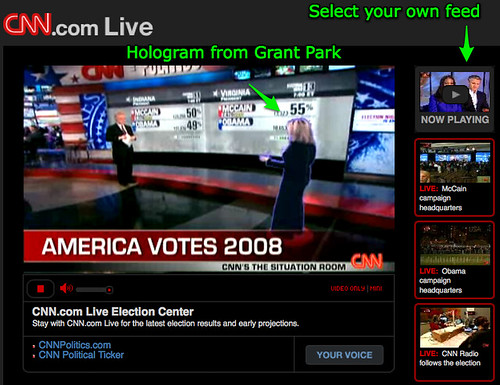Major props to Wendy Drexler for her work on the following video. In a 5 minute CommonCraft inspired video, she does an excellent job of explaining what connected learning is all about. This is a video that she created as part of her culminating experience for her CCK08 (Connected Learning) class that she recently completed.
Stop on over to Wendy's blog to read her post on her project and to read the many comments that she has already received.
Thoughts and reflections on the world of educational technology...oh, and a few other things
Sunday, November 30, 2008
Monday, November 17, 2008
NCSS 2008 Presentation Summary
 This is my third year of attendance at the NCSS annual conference and I was quite happy to have the opportunity to present with my good friend and colleague, Chuck Taft. Our presentation was titled, "21st Century Tools in the Social Studies Classroom" and it is archived and posted online here (a shout out goes to Chuck for his excellent work on building out this resource). Our goal was to build a 60 minute presentation in which we would share as many practical lessons and projects with the participants. We shared a historical simulation of the Lewis and Clark expedition, our Washington DC Travelogue, interactive campaign 2008 cartoon timelines, virtual press conferences with George Washington, and many other samples that are posted at the example page of our presentation website. Chuck and I were pleased that we had so many people attend our session, but honestly, I think the experience of collaborating with one another during the construction of this presentation was the real value to each of us professionally. A highlight of the presentation itself for me was the skype conversation with our student radio show team members, Natalie and Annie. Natalie and Annie did a wonderful job of giving a project overview and relaying their enthusiasm for the Gator Radio Experience to our session participants.
This is my third year of attendance at the NCSS annual conference and I was quite happy to have the opportunity to present with my good friend and colleague, Chuck Taft. Our presentation was titled, "21st Century Tools in the Social Studies Classroom" and it is archived and posted online here (a shout out goes to Chuck for his excellent work on building out this resource). Our goal was to build a 60 minute presentation in which we would share as many practical lessons and projects with the participants. We shared a historical simulation of the Lewis and Clark expedition, our Washington DC Travelogue, interactive campaign 2008 cartoon timelines, virtual press conferences with George Washington, and many other samples that are posted at the example page of our presentation website. Chuck and I were pleased that we had so many people attend our session, but honestly, I think the experience of collaborating with one another during the construction of this presentation was the real value to each of us professionally. A highlight of the presentation itself for me was the skype conversation with our student radio show team members, Natalie and Annie. Natalie and Annie did a wonderful job of giving a project overview and relaying their enthusiasm for the Gator Radio Experience to our session participants.Chuck and I really tried to present in a way that involved as many participants inside and outside of the physical space as possible. We created a back channel chatroom space for remote and physical participants to use to interact with each other. The presentation was ustreamed out on the Internet and we had several folks listen in remotely to contribute content (thanks, Pipes!!) The back channel chat was really interesting and is something that I think has real value for use in presentations like this going forward. It was great having everyone in the chat interacting with one another, dropping links, answering questions, etc. The back channel leveraged the collective knowledge of all of the session participants (remote and physical alike) in a way that simply is not possible using traditional methods. Click here to view the chat transcript from our session.
Props to the folks at NCSS, the Houston Convention Center, and the good folks at ABC-CLIO for providing a highly robust wireless Internet connection at the conference this year.
Thanks to everyone who participated and contributed to our presentation yesterday. Chuck and I appreciate it greatly!
Sunday, November 16, 2008
Vanessa Van Petten to Join Parents as Partners on Monday, November 17th
Sorry for the late notice on this, but I did want to let you know that the Parents as Partners team is being joined by Vanessa Van Petten on Monday, November 17th at 9:00 PM Eastern (02:00 GMT on November 18th).
Vanessa will be talking with us about teens and social networking. Join in the conversation live over at Edtechtalk.com/live.
To learn a bit more abot Vanessa, view one of her clips below:
Vanessa will be talking with us about teens and social networking. Join in the conversation live over at Edtechtalk.com/live.
To learn a bit more abot Vanessa, view one of her clips below:
Thursday, November 13, 2008
Lesson Plan: Building collaborative wisdom through the use of a moodle forum
The 8th grade students recently read Persepolis, which is a graphic novel about a young person's experience after the Islamic revolution in Iran. This is the first time that their teacher, Christina Gwin, has used the graphic novel genre in class with her students. After reading the book, she was planning on doing an a discussion activity in the classroom where her students would analyze images related to the book. She was planning on doing this in a traditional discussion format with students responding to images displayed on the projector in the front of the room. Christina was interested in some type of method to actively involve more students in the discussion at the same time. So, Christina decided to use a moodle discussion forum to facilitate a concurrent discussion. We created a forum with 18 different discussion topics for each of the 18 photos that she wanted her learners to evaluate, compare and contrast . Each discussion topic had a photo and a series of unique questions for the learners to respond to. The students were only required to reply to 5-6 of the photos, but they were required to at least look at all of the photos and to skim some of the replies. See the screenshots at the end of this post for more detail about what this looked like in moodle.
This was all done in roughly 45 minutes and here is what I observed (keep in mind that this really was the first time that the students ever used moodle).
1. ALL students contributed to the discussion for the entire time period. They were engaged in a way that is not possible in a traditional classroom discussion where one learner has the floor at a time.
2. A student or two jumped right on facebook when we started. I provided a re-direct and they closed out of facebook and worked on the discussion at hand without further distraction.
3. We had one problem with the lesson and that was time. When the class period came to an end, all of the students were quite busy contributing to the forum. They seemed to have lost track of time. What a nice problem to have!
While the activity went extraordinarily well, the next time we do something like this I think I'd consider modifying the follow up activity. The students had a follow up homework assignment that essentially required them to reflect upon their experience in class that day. Students were told to complete this in a word processor and then print it off and turn it in the next day. I'm thinking that they could've done this via a moodle web form assignment. At a minimum I believe this would've streamlined the process for turning in the follow up assignment to Christina.
Props to Christina for taking the risk with this project as we are both very new to moodle and of course this activity certainly could've flopped on us. But it didn't flop, and in fact it was quite successful and now gives us a broader base of experience from which we can build more powerful learning experiences in the future.
Below are a series of screenshots that show what the assignment looked like in moodle (click the photos for a better view of each):
Screenshot #1:

Screenshot #2:

Screenshot #3:

Screenshot #4:

This was all done in roughly 45 minutes and here is what I observed (keep in mind that this really was the first time that the students ever used moodle).
1. ALL students contributed to the discussion for the entire time period. They were engaged in a way that is not possible in a traditional classroom discussion where one learner has the floor at a time.
2. A student or two jumped right on facebook when we started. I provided a re-direct and they closed out of facebook and worked on the discussion at hand without further distraction.
3. We had one problem with the lesson and that was time. When the class period came to an end, all of the students were quite busy contributing to the forum. They seemed to have lost track of time. What a nice problem to have!
While the activity went extraordinarily well, the next time we do something like this I think I'd consider modifying the follow up activity. The students had a follow up homework assignment that essentially required them to reflect upon their experience in class that day. Students were told to complete this in a word processor and then print it off and turn it in the next day. I'm thinking that they could've done this via a moodle web form assignment. At a minimum I believe this would've streamlined the process for turning in the follow up assignment to Christina.
Props to Christina for taking the risk with this project as we are both very new to moodle and of course this activity certainly could've flopped on us. But it didn't flop, and in fact it was quite successful and now gives us a broader base of experience from which we can build more powerful learning experiences in the future.
Below are a series of screenshots that show what the assignment looked like in moodle (click the photos for a better view of each):
Screenshot #1:

Screenshot #2:

Screenshot #3:

Screenshot #4:

Wednesday, November 12, 2008
Interview with Tyrone Brown

Note to edtech folks: This is a recording from our 8th grade trip to Washington DC.
I had the good fortune to interview our tour bus driver from last spring's Washington DC trip, Tyrone Brown. We recorded this conversation while we were at Mt. Vernon. As you'll see from the interview, Ty is an exceptional man. The kids and adults who have the opportunity to be on Ty's bus are quite privileged. I hope you enjoy this conversation.
Direct Link to audio file
Tuesday, November 11, 2008
This is why students should post their content online...
Chuck Taft, one of the best teachers I've ever had the privilege of working with, and I have been planning out our presentation for this coming Friday at NCSS (National Social Studies Teachers) conference in Houston, TX. As we were preparing the other night for the presentation, we discussed some of the student samples that we'll be sharing. Two years ago we had students create a first person account from an event that took place during the US Civil Righs movement in the 1960s. All of these videos were posted online at youtube. I distinctly recall some of the students at the time saying, "Why are we posting these on YouTube, nobody will ever watch them." Well, here is a video that has over 7500 views on YouTube. If this was only burned to a DVD or if this project was a three panel poster board, it might have been lucky to have been viewed by 50 people. These students made a difference by creating and publishing a media sample that has had (and will continue to have) an impact.
The content that our students create and publish online has value. It means something and makes a difference. Enjoy:
Chuck Taft and the American History Rules Channel on YouTube
The content that our students create and publish online has value. It means something and makes a difference. Enjoy:
Chuck Taft and the American History Rules Channel on YouTube
Thursday, November 06, 2008
The Impact of Election Technology on K12
 I was simply blown away by the different media technologies, some new and some older, that I interacted with on election day this past Tuesday. As someone who does not own a traditional television, I'm always searching out ways to find what I'm missing through TV on the Internet. At school on Tuesday morning I worked with Mary Jean Conlon, our super librarian at Castilleja, to get the CNN online coverage up and running in the library so students and teachers would be able to check out the coverage. After school was over, I tuned into this same online coverage on my laptop in my office. A few minutes after I began watching, CNN used hologram technology to bring a Grant Park reporter into the studio virtually (see screenshot). As an edtech nerd, the first thing that came into my mind was, "Wait until skype offers this feature!" In all seriousness, think of the implications on K12 education this technology might have?? Hey, two way skype video as a tool to bring experts from around the world into our classrooms makes for some powerful learning, but wait until we can hologram folks into our classroom!! Think of the possibilities!
I was simply blown away by the different media technologies, some new and some older, that I interacted with on election day this past Tuesday. As someone who does not own a traditional television, I'm always searching out ways to find what I'm missing through TV on the Internet. At school on Tuesday morning I worked with Mary Jean Conlon, our super librarian at Castilleja, to get the CNN online coverage up and running in the library so students and teachers would be able to check out the coverage. After school was over, I tuned into this same online coverage on my laptop in my office. A few minutes after I began watching, CNN used hologram technology to bring a Grant Park reporter into the studio virtually (see screenshot). As an edtech nerd, the first thing that came into my mind was, "Wait until skype offers this feature!" In all seriousness, think of the implications on K12 education this technology might have?? Hey, two way skype video as a tool to bring experts from around the world into our classrooms makes for some powerful learning, but wait until we can hologram folks into our classroom!! Think of the possibilities!I also really enjoyed CNN's multiple streams in their online coverage. I loved having the option to toggle between different feeds...it just seemed to add to the excitement in a way that static/traditional TV can't do.
The other media avenue that I fully enjoyed participating in was Twitter. I was completely glued to the Twitterstream...I follow people from all over the world and it was so interesting to get this first person, "boots on the ground" perspective that simply is not possible through the traditional television media. I absolutely loved the social nature of the experience, with twitterpals from all over the place sharing their take on the historic day. Again, the edtech geek in me thought about the possibilities associated with this form of media in the classroom. Twitter is a fantastic platform for building a network and for "making friends all over the world," which is something that Alan November thinks we should be teaching our kids to do (and I happen to agree with him). Once you have a "boots on the ground" network of people all across the globe, the possibilities for authentic learning becomes nearly limitless.
Subscribe to:
Posts (Atom)